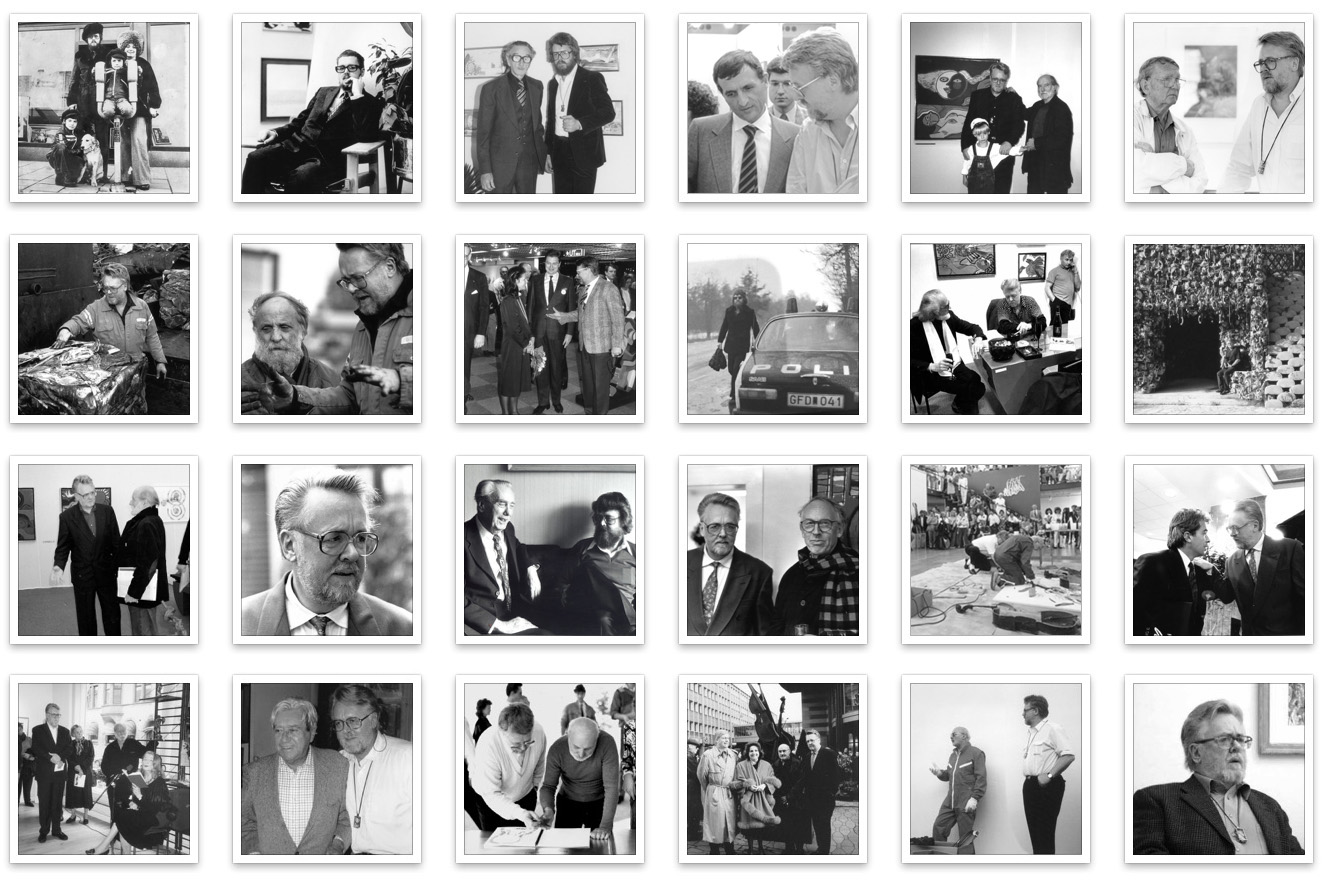
Siwert Bergström
* 28 August 1937
† 21 November 2020
* 28 August 1937
† 21 November 2020

An undying passion for art
Words of remembrance by Johan Persson
Siwert Bergström. You had the courage to tread your own path. You were bold enough to put your trust in artists you genuinely believed in. You were, for many decades, a force of nature in the Swedish art world.
News of your passing is a source of great sadness to me. What inevitably springs to mind, however, now as always when I think of you, is your almost magical ability to conjure forth the most outstanding exhibitions of art. You combined good art with ingenious detail. You were both a gallerist and an artist’s soul in one and the same person.
Siwert Bergström was born in 1937 into a free-church family in Småland, Sweden. Initially he hoped to devote his life to music; his dream was to become a professional musician and he applied himself wholeheartedly to learning to master the violin. Sadly, however, his plans came to nought when he was denied a place at the Academy of Music. Nonetheless, life for Siwert Bergström continued apace. By the age of just 22 he had already sailed on the Swedish America Line onboard MS Gripsholm, working in the ship’s kitchen. He also trained at a glassworks in Småland. He learned the confectioner’s trade, attracted by the creative opportunities that this profession so richly offers, and he and his wife, Solveig, opened a patisserie in Kättilstorp and later in Huskvarna. It was during these years their sons, Thomas and Karl-Johan, were born. However, when relentless competition from the big department stores in the 1960s spelled the beginning of the end for the little family-owned patisserie, art made its entrance into the lives of Siwert and Solveig. With typical passion and resolve, Siwert turned his burgeoning interest in the work of the Halmstad Group of artists into opportunities to stage exhibitions of their paintings. Galleri Kända Målare (‘The Well-known Painters’ Gallery’), later to become GKM, had taken its first steps.
It was now 1967 and the gallery was on Bredgränd Street in Jönköping. Collaboration with the Halmstad Group led Siwert first to a studio outside Paris where they produced graphic prints. Despite not being able to speak a word of the language, he boldly got on the train to France and used the long journey to acquaint himself with the all-important French words for a myriad different colours. It was in this vibrant metropolis of art that he made the acquaintance first of Bengt Lindström and, through him, Corneille. One contact led to another and before long the gallery’s palette of artists came to include names such Karel Appel, Jacques Doucet, Arman, César, Erró, Valerio Adami, Peter Klasen, Roberto Matta and many others. Collaboration with these artists became increasingly close and intense, and the trips to Paris became more and more frequent. Between 1981 and 1995 the gallery took part in the FIAC international art fair in the Grand Palais. Paris became a home from home for Siwert and over the years he learned to speak fluent French. In 1984, when Siwert expressed a wish to move closer to the continent, Corneille spoke warmly as an advocate of Malmö, where he had held an exhibition in the 1950s. So it was that the gallery moved from Jönköping to its current address on Stora Nygatan, a bustling thoroughfare in the heart of Malmö.
In addition to all of the art exhibitions he arranged, Siwert also published numerous editions of graphic works and sculptures over the years, as well as many exquisite art books. Among his many talents was his flair for establishing contacts with and between artists, authors and translators: Artur Lundkvist, Maria Wine, Pierre Restany, Michel Ragon and Lasse Söderberg, to name but a few. Further testimony to his instinct and intuition was his success in persuading Octavio Paz to write a suite of prose poems, ‘The Heart is an Eye’, to accompany the paintings in the gallery’s book on Roberto Matta. This was published in 1988, two years before Paz was awarded the Nobel Prize for Literature.
Siwert was a bird forever on the wing towards new destinations. Driven by the desire to constantly create new exhibitions for ever more artists, in the 1990s he turned the gallery’s gaze eastwards to showcase the work of several well-known artists from Estonia, including Raul Meel and Olev Subbi.
One attribute in particular that distinguished Siwert was the faith he showed in gifted young artists by purchasing their works. One such beneficiary of this encouragement was Patrick Chappert-Gaujal, an outstanding sculptor from the south of France who lived in Malmö for a time in the late 1980s.
Among the highlights in Siwert’s life was the happening that the gallery arranged at Lund’s Konsthall, the municipal art gallery in Lund, in 1989 with the world-famous artist Arman. No less successful was the event a year earlier at which Cesár, another big name on the world stage, presided over the compression of an old Volvo in front of a live audience.
Siwert Bergström’s life was one of constant progress, continuously spurred on by the desire to discover more and by an intellectual curiosity that sought to fuse words and images. In the early 1990s he was privileged to receive from the hand of President Mitterand the order of Chevalier des Arts et des Lettres, one of France’s most prestigious awards for contributions to the propagation of culture. When, on the day of the award, his car was caught up in a traffic jam in Paris, Siwert stopped a passing policeman, showed him the invitation he had to the ceremony and was duly escorted at breakneck speed with flashing blue lights to the very gates of the Élysée Palace.
Siwert Bergström’s departure from this earthly life has left a hollow echo. I will, however, remember the warmth and generosity of his personality. Behind him he has left countless editions and art books. Together, all of this is a synthesis of his life’s work and a testament to his love of art.
Johan Persson

Half a Century with GKM
Gold! There was never a shadow of doubt about what colour this book should be. They call a 50th wedding anniversary a golden wedding, don’t they? And in our opinion half a century is well worth celebrating. After all, what can surpass a milestone like that? There is always a centenary celebration, of course, but as we are unlikely to be quite as agile half a century from now, we’ll leave that to the generations to come.

